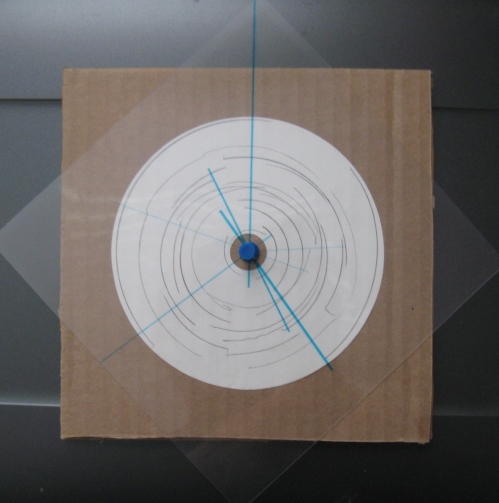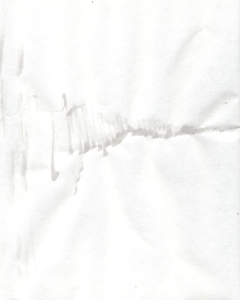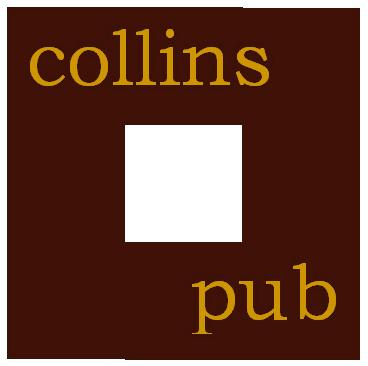Radiating Lines performance score
For your consideration a new score and the first piece of music I’ve recorded since February. Radiating Lines is an example of a Meta-Score in that it is a score that generates a unique score every time you use it. I made during the John Cage Centenary week though it is not specifically dedicated to him. It certainly owes plenty to Cage as I think he was he first to use transparencies and in the construction of the score one is completely free to use chance operations but it is not required. But certainly a Post-Cage and one’s whose debts are I hope are clear. Anyway on to the score (PDF download).
—
Radiating Lines
For any instrumentation and any number of performers
Components
• A circular background mounted on a square backing matte
• A square overlay the same size as the square matte
• Mounting hardware of some sort
• These Instructions
Constructing the score
The included background and overlay materials can be simply printed out and put together as described in section 3 below. However if one wishes to create a unique version of the score the following instructions will guide you through the process.
1) The background
Take a circular piece of paper and numerous circular objects. With a pencil trace around these objects. The placement of the objects should be roughly centered. Tracings should be done quickly and mostly partially. This process should be done as unintentionally as possible. Chance procedures can be used as a guidance but are not required.
Mount this circular on a square backing matte that is 25 to 30% larger than the circular background. This matte should facilitate the mounting of the transparent over ally so that it can spin. E.G. allow a push pin or other mounting device.
2) The Overlay
The overlay is a series of lines of different weights originating from a common center. The lines should extend to both directions of the centering at varying lengths. Again these can be created “by eye” without intention or via chance procedures. There should be 4 to 8 lines that extend both directions from the center (8 to 16 lines radiating from the center). At least one line should extend beyond the total size of the transparency (which is the same size as the backing matte). If more then one line is of this length they must be of different weights
The overlay should be printed onto a transparency which should be cut to the same dimensions as the backing matte.
3) Assembling the score
The circular score should be mounted to the backing matte perfectly centered. The transparent overlay should be also centered and mounted with a push pin or some other device that allows it to be rotated.
Performing the score
General
Radiating Lines can be performed with any instrumentation over the length of time required to get through all of the material. It can be simultaneously performed by any number of players each of which should have their own score and which should independently follow these instructions.
Setup
Each performer should take their copy of the score and rotate the overlay to an individually set position. This position can be set at the performers discretion or via some form of chance procedure.
Performance instructions
The longest, thickest line should be placed topmost and is the starting line for performance. The score can be read clockwise or anti-clockwise. On beginning the material in between this starting line and the next line – referred to as a “wedge” – should be played. Only the material that is in-between both lines should be played. That is if there is material above the length of one of the lines it should not be interpreted. All aspects of the material should be considered including spaces between material, overlapping sections, differences in densities, imperfections and so on.
After playing all the material in a give wedge the next wedge should be moved to in the direction chosen by the performer. This wedge should be gone through silently in a manner corresponding to the length of time that a given wedge would take to perform the material. That is to say that every other wedge should be silent for the length time it’d take to perform it. The circle should be gone around twice in order that all of the material be either interpreted or considered silently.
All material must be played – the performance should continue for as long as this takes. When played with multiple performers the material should be played independently with no attempt to coordinate beyond the initial start. The piece concludes when all performers have performed all of the material.
—
First Recording
For the first realization of this piece I played through the score several times with three different instruments: a pentatonic lyre, a Steim Cracklebox and a Prepared Piano iPad app. The latter uses samples made from John Cage’s preparations and is a great app available on several platforms (a perfect tablet app – worth the US$1). These three separate recordings were multi-tracked together as per the instructions – that is to say as if they were recorded live by three people. Each track is a different length, so they start together initially but end at different times generating an effect of a gradual thinning out of the ensemble. The lyre is recorded open air so there is a bit of a field recording aspect in that layer. Anyway give it a listen for yourself and as always I reccomend downloading the uncompressed version from Soundcloud.















You must be logged in to post a comment.